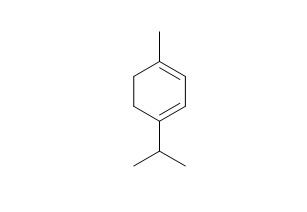alpha-Terpinene
alpha-Terpinene has antioxidant activity, it induces oxidative stress, cytotoxic and genotoxic effects in liver tissue involving the caspases activation.
Inquire / Order:
manager@chemfaces.com
Technical Inquiries:
service@chemfaces.com
Tel:
+86-27-84237783
Fax:
+86-27-84254680
Address:
1 Building, No. 83, CheCheng Rd., Wuhan Economic and Technological Development Zone, Wuhan, Hubei 430056, PRC
Providing storage is as stated on the product vial and the vial is kept tightly sealed, the product can be stored for up to
24 months(2-8C).
Wherever possible, you should prepare and use solutions on the same day. However, if you need to make up stock solutions in advance, we recommend that you store the solution as aliquots in tightly sealed vials at -20C. Generally, these will be useable for up to two weeks. Before use, and prior to opening the vial we recommend that you allow your product to equilibrate to room temperature for at least 1 hour.
Need more advice on solubility, usage and handling? Please email to: service@chemfaces.com
The packaging of the product may have turned upside down during transportation, resulting in the natural compounds adhering to the neck or cap of the vial. take the vial out of its packaging and gently shake to let the compounds fall to the bottom of the vial. for liquid products, centrifuge at 200-500 RPM to gather the liquid at the bottom of the vial. try to avoid loss or contamination during handling.
The Catharanthus Genome2022,35-83.
Sains Malaysiana2022, 51(4):1143-1154
Plants (Basel).2021, 10(2):278.
Foods. 2022, 11(23):3905.
Molecules 2022, 27(3),1047.
Food Addit Contam Part A.2021, 38(12):1985-1994.
Molecules.2022, 27(5):1675
Journal of Medical Sciences2024, 44(5):p 222-227.
Phytomedicine.2020, 79, 153351
J Korean Soc Food Sci Nutr2023, 52(12):1248-1255
Related and Featured Products
Chemical Research in Toxicology, 2012, 25(3):713-721.
α-Terpinene, an antioxidant in tea tree oil, autoxidizes rapidly to skin allergens on air exposure.[Reference:
WebLink]
The monoterpene alpha-Terpinene is used as a fragrance compound and is present in different essential oils. It is one of the components responsible for the antioxidant activity of tea tree oil. alpha-Terpinene is structurally similar to other monoterpenes, e.g., limonene, known to autoxidize on air exposure and form allergenic compounds. The aim of the present study was to investigate the possible autoxidation of alpha-Terpinene at room temperature.
METHODS AND RESULTS:
To investigate the sensitization potency of air-exposed alpha-Terpinene and the oxidation products formed, the murine local lymph node assay was used. Chemical analysis showed that alpha-Terpinene degrades rapidly, forming allylic epoxides and p-cymene as the major oxidation products and also hydrogen peroxide. Thus, the oxidation pathway differs compared to that of, e.g., limonene, which forms highly allergenic hydroperoxides as the primary oxidation products on autoxidation. The sensitization potency of alpha-Terpinene was increased after air-exposure. The allylic epoxides and a fraction, in which only an α,β-unsaturated aldehyde could be identified, were shown to be strong sensitizers in the local lymph node assay. Thus, we consider them to be the major contributors to the increased sensitization potency of the autoxidized mixture. We also investigated the presence of alpha-Terpinene and its oxidation products in four different tea tree oil samples of various ages.alpha-Terpinene and its oxidation products were identified in all of the tea tree oil samples.
CONCLUSIONS:
Thus, from a technical perspective, alpha-Terpinene is a true antioxidant since it autoxidizes rapidly compared with many other compounds, preventing these from degradation. However, as it easily autoxidizes to form allergens, its suitability can be questioned when used in products for topical applications, e.g., in tea tree oil but also in cosmetics and skin care products.
Journal of Applied Biomedicine, 2017:S1214021X16303507.
Monoterpene alpha-terpinene induced hepatic oxidative, cytotoxic and genotoxic damage is associated to caspase activation in rats.[Reference:
WebLink]
The aim of this study was to investigate the occurrence of toxic effects in liver tissue of rats treated with α-terpinene.
METHODS AND RESULTS:
All treatments were intraperitoneally administered at doses of 0.5, 0.75 and 1.0 ml kg−1 during 10 days. Liver samples were collected and assessed by histopathological analysis, caspases -1, -3, -8 assay, biomarkers of hepatic damage and determination of oxidant/antioxidant status (thiobarbituric acid-reactive substances (TBARS), catalase (CAT), superoxide dismutase (SOD), reactive oxygen species (ROS), glutathione S-transferase (GST) and glutathione peroxidase (GPx)). Additionally, the cytotoxic and genotoxic effects were evaluated by comet assay. An increase was observed on TBARS levels and GPx activity on the hepatic tissue. Instead, CAT and SOD activities decreased in rats treated with a dose of 1.0 ml kg−1 of alpha-Terpinene. Concomitantly, ROS levels increased and GST levels decreased in rats treated with alpha-Terpinene at doses of 0.5, 0.75 and 1.0 ml kg−1. Also, there was an increase in frequency of damage, damage index and caspases, while cell viability decreased in rats treated with alpha-Terpinene. Alanine aminotransferase and aspartate aminotransferase increased in rats treated with 1.0 ml kg−1 of alpha-Terpinene.
CONCLUSIONS:
Therefore, alpha-Terpinene induces oxidative stress, cytotoxic and genotoxic effects in liver tissue involving the caspases activation.
Journal of animal science, 2005, 83(8):1967-1971.
Effects of γ-terpinene, terpinolene, α-copaene, and α-terpinene on consumption of alfalfa pellets by sheep.[Reference:
WebLink]
Although plant secondary chemistry influences shrub consumption by free-ranging ruminants, the effects of many specific compounds on herbivores have not been examined.
METHODS AND RESULTS:
We conducted four experiments to examine effects of individual terpenes on alfalfa pellet intake by lambs. Forty-five lambs were individually fed alfalfa pellets sprayed with gamma-terpinene, terpinolene, alpha-copaene, or alpha-Terpinene at one of five concentrations in an ethanol carrier. Treatments (0, 0.5, 1, 2, and 10x) were multiples of the concentration (x) of a specific terpene on the leaf surface of Flourensia cernua (a low-preference shrub for domestic ruminants). Terpenes were applied to alfalfa pellets (0.64 kg.lamb(-1).d(-1), DM basis), and consumption was measured during a 20-min interval for 5 d. A day effect was detected for gamma-terpinene on intake (P < 0.001 for both linear and quadratic contrasts). No effect of terpinolene, alpha-copaene, or alpha-Terpinene on intake was detected in this study.
CONCLUSIONS:
None of the terpenes tested was strongly related to intake of alfalfa pellets by lambs under the conditions of this study.



